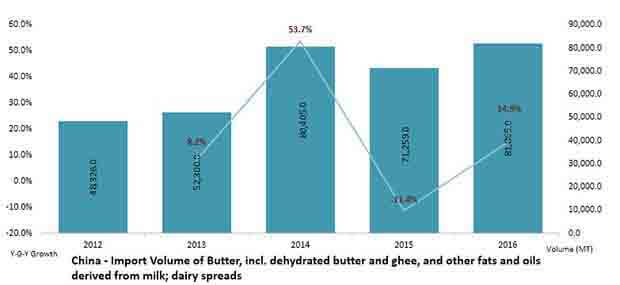Anhydrous Milk Fat Segmented By nature that is Organic Anhydrous Milk Fat, Conventional Anhydrous Milk Fat used in Confectionery, Bakery, Flavours, Dairy Products, Soups aand sauces, Dairy spreads, Ice cream, Processed Cheese, Frying, grilling, roasting.
Industry: Food and Beverages
Format: PPT*, PDF, EXCEL
Delivery Timelines: Contact Sales
Report Type: Ongoing
Report ID: PMRREP22618
Anhydrous milk fat, also known as anhydrous butteroil, ghee, and butteroil, is a product derived from cream or butter which involves almost total removal of water and non-fat solids thus making the fat content in anhydrous milk fat more than 99% of the total volume.
Though anhydrous milk fat is a modern industrial product, but it has its roots established in the ancient traditional culture of India and Arab countries where Ghee, a dairy product with more protein and more characteristic flavor than anhydrous milk fat is consumed from centuries.
Demand for AMF is increasing as an ingredient due to its high stability and longer shelf life. Anhydrous milk fat can be stored for several months at low temperature while at the same temperature butter turns putrid after some time and requires at least –25°C temperature for storage.
Unlike butter, AMF can be transported without refrigeration which increases its functionality and ease of use which is anticipated to drive the growth of anhydrous milk fat in developing regions, especially Asia-Pacific where there is lack of infrastructure over the supply chain and lack of proper storage facilities, which limits refrigerated products to major urban conglomeration.
AMF finds its use as an ingredient in various products such as caramels, toffees, chocolate and imitation chocolate, fudges, flavors, recombined UHT milk, evaporated milk, ice cream, cheese and yogurt, soups & sauces, dairy spreads etc. as it is easy to mix and meter into other products which is expected to drive the growth of anhydrous milk fat over the forecast period.
Consumers are changing their approach for the healthier product, instead of looking only for functional ingredients, they’re emphasizing more on natural products and avoiding products which are full of additives, preservatives, and stabilizers even though the product claims to be low fat.
In addition, consumers are unwilling to compromise on taste and are following holistic approach towards their health which is increasing the demand for products with buttery flavors thus driving the growth of anhydrous milk fats as they offer consistent flavor, texture, mouth-feel, structure, and anti-bloom properties.
Moreover, demand for anhydrous milk fat is also increasing as an ingredient in dairy spreads as they provide firmness, plasticity, lubricity, viscosity, and compatibility with other fats.
In addition, owing to increasing trend of clean label products, modern consumers read ingredient lists and labels very carefully and want to have full control over what they eat, every day are opting for more natural food products. Anhydrous milk fat checks all boxes as it contains no additives, imparts good dairy flavor and is naturally sourced which is anticipated to supplement the growth of anhydrous milk fat market in the near future.
| basis of nature |
|
| basis of application |
|
| basis of distribution channel |
|
Some of the key players operating in the global Anhydrous Milk Fat market are Arla Foods Ingredients Group P/S, FrieslandCampina, Uelzena Ingredients, Fonterra Co-operative Group Limited, Corman SA, Murray Goulburn, Flechard SAS, Dairy Crest Group plc, Ornua, Groupe Lactalis S.A., Land O'Lakes, Inc., Glanbia ingredients, Gaylea, Agropur, Royal VIN Buisman, Flanders Milk, Marsh's Dairy Products, Meadow Foods, The Tatua Co-operative Dairy Company Ltd, Büllinger SA (BE) Apis Food, Epi ingredients, Uhrenholt among other anhydrous milk fat players
Increasing per capita consumption of dairy products in Asia Pacific region poses a lucrative opportunity for manufacturers to expand their operations in China and India. For instance, according to International Trade Centre, there has been an increase in the import of butter and other related products such as anhydrous milk fat to cater the surging demand, which clearly shows huge market potential in these countries.
Moreover, in the matured market, manufacturers can focus on offering custom solutions to their clients such as fractionated milk fats, to comply with a dynamically changing trend among consumers regarding consumption of dairy products.

A modelling-based approach and triangulation methodology will be followed to estimate data covered in this report.
A detailed market understanding and assessment of the applications, types, forms and end uses of the product segments covered in the study is followed by carrying out a demand-side approach to estimate the sales of target product segments, which is then cross-referenced with a supply-side assessment of value generated over a pre-defined period.
The statistics and data is collected at a regional level, consolidated and synthesized at a global level to estimate the overall market sizes.
Some of the key data points covered in our report on include:
To know more about delivery timeline for this report Contact Sales
